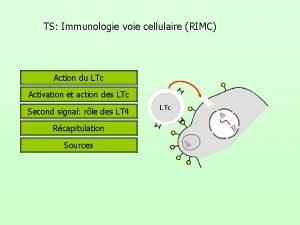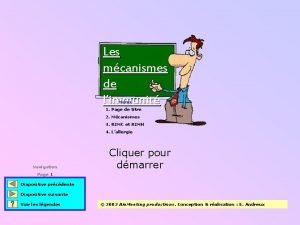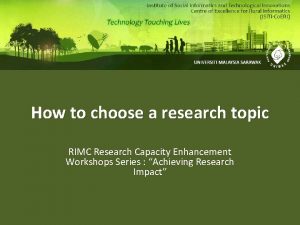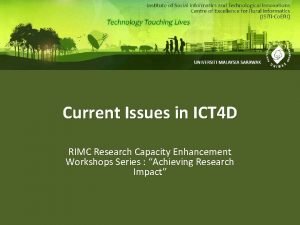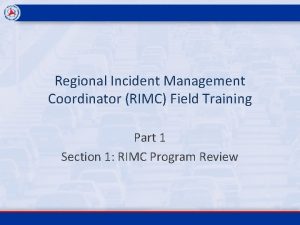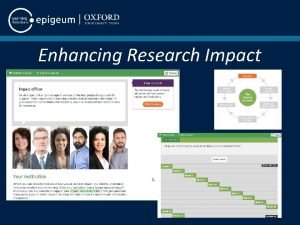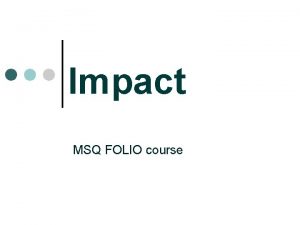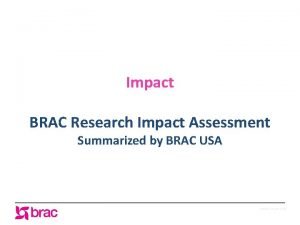What is the impact of research RIMC Research














- Slides: 14

What is the impact of research? RIMC Research Capacity Enhancement Workshops Series : “Achieving Research Impact”

Higher Education Minister Datuk Seri Mohamed Khaled Nordin Does everyone know what he means by impact? “Universities should live up to their roles within the local community while making an impact in the international arena. ” Higher Education Minister Datuk Seri Mohamed Khaled Nordin

What is the impact of research? Research Impacts Academic Impact Publications Citations Training Academic Research Socio-economic Impact Socioeconomic benefits Public Policy Capacity building

• Achieving either type of impact does not automatically lead to achieving the other Research Impact • There are considerable differences between the processes that lead to each • High quality research is always the starting point for both • Non-academic impacts require more attention than academic • Cross discipline research will better influence wider society Research Impacts Academic Impact Publications Citations Training Academic Research Socio-economic Impact Socio-economic benefits Public Policy Capacity building My question is, are we making any impact?

• Policy making processes are weakly informed by research-based evidence • Policy-makers are influenced by: Influencing public policy Socio-economic Impact Public Policy – their own values, experience, judgment – lobbyists and pressure groups, – pragmatism. • They will take more or less anything that: – – can help them to make a decision seems reasonable has a clear message is available at the right time • Researchers: – – – want everything proven scientifically need results to be underpinned by theory wrap their message in caveats and qualifications.

1. Context Three domains of the impact of research on public policy Could you kindly rephrase that in equivocal, inaccurate, vague, self-serving and roundabout terms that we can all understand? § prevailing narratives and discourse among policy-makers § extent of demand for new ideas § political culture and degree of openness 2. Evidence § § § research provides a solution to a problem participatory approaches and pilot schemes communications and influencing strategy results packaged in familiar concepts strenuous advocacy efforts 3. Links § feedback between researchers and policymakers § trust, legitimacy, openness and formalisation of networks

1. Academic credibility – Key factors shaping the external influence of academic researchers Prestigious institutions, publications, citations 2. Disposition – Desire for impact and research preferences; 3. Networking skills – The main factor for using research results is knowing that they exist 4. Personal communication – 5. Public speaking, political sensitivity Interaction expertise – Engaging with the tacit knowledge of external users 6. External reputation – Public profile 7. Experience 8. Track record

• Traditional assessments focus on publications Measuring impact Extract from an application for an academic job: Provide a complete list of publications, including original research papers as first author, senior author, impact points total in the last 5 years with marked first and last-authorships, personal Scientific Citations Index (SCI, h-index according to Web of Science) for all publications. They don’t care what you’ve published, only where. – Only indicates the intrinsic quality of the research, not its usefulness • Academic publishing Impact Factors are; – “Negotiable – Non-reproducible – Mathematically unsound” • Trend towards evidencebased policy-making increases the demand for ‘evidence’

Citations • Proprietary bibliometric systems for tracking citations: – ISI Web Of Knowledge (Thompson) – Scopus (Elsevier) • Internet-based citation-tracking systems: – Google Scholar (for journal articles and other academic papers) – Google Books – Scirus (Elsevier) – ‘Public or Perish’ downloadable software (Prof Harzing) • • A book will take longer to be cited but will be cited for longer Book chapters are often hard to find are poorly referenced. Ensure abstracts contain key ‘bottom line’ or ‘take-away points’. Co-authored outputs generate more citations due to networking effects between authors The more you publish the more citations you’ll get (=more research & less teaching etc. ) Across all disciplines in the social sciences journal articles account for the majority of citations Citation measurement – h-score ; ‘ 5’ means that you have at least five papers which have attracted at least five citations each – favours older researchers with more publications – g-score; variant that favours researchers with a few very highly cited publications

Evidence-based policy making • Informed by a belief that research will improve policy and practice. • Researchers can enhance their research impact by recognising that: – Publication, even electronically, is not the same as facilitating access; – Dissemination is not the same as reaching your target audience; – Reaching your target audience is not the same as having an impact.

Stages of impact Traditional Quality Domain Research Outputs • Discoveries • Publications • Patents Economic Social Full Scope of Research Impact Research Transfer Engagement with end-users Research Outcomes New or improved products or services Research Impact Value added improvements achieved National Benefits • Licenses • Royalties • Pilots • Prototypes • New products • New services • Start-ups • Joint ventures • Repeat business • Productivity • Cost savings • Competiveness • Employment • Investment • Informing Government & industry • Engaging with community groups • Management practices • New or improved Government policy • Savings in natural resources • Reduced waste • Improved health/well being

e. Bario impact stages Traditional Quality Domain Research Outputs • Publications • Media • Awards Economic Social Full Scope of Research Impact Research Transfer Engagement with end-users Research Outcomes New or improved products or services Research Impact Value added improvements achieved • More tourists • More flights • e. BKF • e. Bario Sdn Bhd • Co. ERI-ISITI • Radio Bario • Community radio policy • Rural development • DAGS/Mo. STI • FORMADAT National Strategic Framework for Bridging the Digital Divide -> 8&9 MP • Knowledge centres National Benefits

Engaging with end-users Knowledge Demand Passive Distribute standard products Knowledge Supply Active Distribute customised products Passive / Latent Actively requesting The Knowledge Attic The Knowledge Publisher An archive in which material is collected and stored A system which allows users to request information, but which does not respond with a tailored supply The Knowledge Pump The Knowledge Dialogue A system that tries to deliver information selectively to people who are believed to need it A system which enables users to request information and which responds with a corresponding supply From: van Heijst, G. , van der Spek, R. and Kruizinga, E. (1998) ‘The lessons learned cycle’, in Borghoff, U. M. and Pareschi, R. (eds) Information Technology for Knowledge Management. Berlin: Springer Verlag, pp. 17 -34.

• The Knowledge Attic Engaging with its end-users Knowledge Demand Passive / Latent Passive Distribute standard products Knowledge Supply Active Distribute customised products The Knowledge Attic Actively requesting The Knowledge Publisher An archive in which material is collected and stored A system which allows users to request information, but which does not respond with a tailored supply The Knowledge Pump The Knowledge Dialogue A system that tries to deliver information selectively to people who are believed to need it A system which enables users to request information and which responds with a corresponding supply – You may have many publications but are they organised in a single repository. Do you have a Working Paper series or a dedicated journal • The Knowledge Publisher – Do you know who your audience is? Do you engage with them in a way that would facilitate requests for information? • The Knowledge Pump – Do you have a mechanism for discovering the information needs of your audience? • The Knowledge Dialogue – Do you have mechanisms for discovering the information needs of you audience and then supplying them?
 Phase effectrice de la rimc
Phase effectrice de la rimc Rimc et rimh
Rimc et rimh Hát kết hợp bộ gõ cơ thể
Hát kết hợp bộ gõ cơ thể Lp html
Lp html Bổ thể
Bổ thể Tỉ lệ cơ thể trẻ em
Tỉ lệ cơ thể trẻ em Gấu đi như thế nào
Gấu đi như thế nào Chụp phim tư thế worms-breton
Chụp phim tư thế worms-breton Hát lên người ơi alleluia
Hát lên người ơi alleluia Các môn thể thao bắt đầu bằng tiếng bóng
Các môn thể thao bắt đầu bằng tiếng bóng Thế nào là hệ số cao nhất
Thế nào là hệ số cao nhất Các châu lục và đại dương trên thế giới
Các châu lục và đại dương trên thế giới Công của trọng lực
Công của trọng lực Trời xanh đây là của chúng ta thể thơ
Trời xanh đây là của chúng ta thể thơ Mật thư anh em như thể tay chân
Mật thư anh em như thể tay chân
